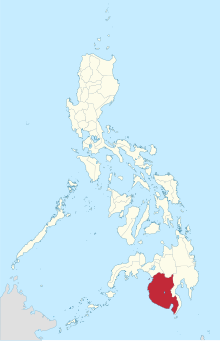| Cotabato | |||||||||||||||
|---|---|---|---|---|---|---|---|---|---|---|---|---|---|---|---|
| Province of the Philippines | |||||||||||||||
| 1914–1973 | |||||||||||||||
 Seal
Seal
| |||||||||||||||
 Location of the historical province of Cotabato. | |||||||||||||||
| Capital |
| ||||||||||||||
| Area | |||||||||||||||
| • | 24,916 km (9,620 sq mi) | ||||||||||||||
| History | |||||||||||||||
| • Established | 23 July 1914 | ||||||||||||||
| • Disestablished | 22 November 1973 | ||||||||||||||
| Political subdivisions |
| ||||||||||||||
| |||||||||||||||
| Today part of | · Cotabato · Maguindanao del Norte · Maguindanao del Sur · Sarangani · South Cotabato · Sultan Kudarat | ||||||||||||||
Cotabato, also known as the Province of Cotabato (Maguindanaon: Kutawatu, كوتوات), was a historical province of the Philippines established in 1914 that existed until its dissolution in 1973. The province's capital from 1920 to 1967 was Cotabato City (of the same name) while Pagalungan became its capital from 1967 to 1973.
Originally a district of the former Moro Province, on September 1, 1914, the defunct Department of Mindanao and Sulu provided with autonomous government through Act No. 2408 enacted on July 23, 1914, converted the district into a province along with other former Moro Province districts: Davao, Lanao, Sulu, Zamboanga, and its former sub-province Bukidnon. Davao, Lanao and Zamboanga were then later split and partitioned into different current provinces, Sulu was then later split and partitioned into the current provinces of Sulu and Tawi-Tawi, and Bukidnon mostly remain what it is today.
The province was one of the largest provinces of the Philippines, with an area of 2,296,791 hectares (22,967.91 km). It was dissolved on 1973, comprising what are now the provinces of Cotabato (North), South Cotabato, Maguindanao del Norte, Maguindanao del Sur, Sultan Kudarat, and Sarangani.
History

Establishment and composition

Upon its separation from the Department of Mindanao and Sulu, Cotabato comprised the municipalities of Cotabato (the provincial capital), Dulawan, and Midsayap, and the following municipal districts:

- Awang
- Balatikan
- Balut
- Banisilan
- Barira
- Buayan
- Bugasan
- Buldun
- Buluan
- Carmen
- Daguma
- Dinaig
- Dulawan
- Gambar
- Glan
- Isulan
- Kabakan
- Kalanganan
- Kiamba
- Kidapawan
- Kitubud
- Kling
- Koronadal
- Lebak
- Libuangan
- Liguasan
- Maganui
- Nuling
- Parang
- Pikit-Pagalungan
- Reina Regente
- Salaman
- Sebu
- Silik
- Subpangan
- Talayan
- Tumbau
On June 18, 1966, South Cotabato was separated from the province through Republic Act No. 4849. That very same day, the provincial capital was moved from Cotabato City to Pagalungan.
Dissolution
On November 22, 1973, the remaining territories of the Province of Cotabato was divided into North Cotabato, Maguindanao and Sultan Kudarat through Presidential Decree No. 341.
On March 7, 1984, North Cotabato was renamed to simply "Cotabato" through Batas Pambansa Blg. 660.
On March 16, 1992, the province of Sarangani was formed out of South Cotabato.
See also
References
- ^ "Presidential Decree No. 341 - Creating the Provinces of North Cotabato, Maguindanao and Sultan Kudarat". Official Gazette of the Republic of the Philippines. Malacañang, Manila, Philippines. November 22, 1973. Archived from the original on September 9, 2017. Retrieved April 27, 2016.
- ^ "Republic Act No. 4849 - An Act Creating the Province of South Cotabato". Chan Robles Virtual Law Library. July 18, 1966. Retrieved April 27, 2016.
- ^ "Our Province". Province of Cotabato. Retrieved April 27, 2016.
The total land area of the original Cotabato before its division was 2,296,791 hectares or about one thirteenth of the whole country which has an area of about 30 million hectares. So big was the original province that its area was about the size of the central plain of Luzon and bigger than six states in the United States, including the states of Massachusetts, Connecticut and Rhode Island. The total land area of the Hawaiian Islands (now a U.S. state) is only about three-fourths that of Cotabato.
- "Act No. 2711; An Act Amending the Administrative Code". Official Gazette of the Republic of the Philippines. March 10, 1917. Retrieved April 27, 2016.
The Province of Cotabato lies east and south of the Province of Lanao, south of the Province of Bukidnon and west of the Province of Davao and contains the following municipalities: Cotabato (the capital of the province), Dulawan, and Midsayap. The province also contains the following municipal districts: Awang, Balatikan, Balut, Banisilan, Barira, Buayan, Bugasan, Buldun, Buluan, Carmen,, Dinaig, Gambar, Glan,, Kabakan, Kalanganan, Kiamba, Kidapawan, Kitubud, Kling, Koronadal, Lebak,, Liguasan,, Nuling, Parang, Pikit-Pagalungan,, Salaman, Sebu, Silik, Subpangan, and Tumbau.
- Patricio P. Diaz (January 23, 2016). "MIND DA NEWS: Bet? Not End of Capitol Rigodon". MindaNews. Retrieved January 23, 2016.
- "Batas Pambansa Blg. 660 - An Act Changing the Name of the Province of North Cotabato to Cotabato". Chan Robles Virtual Law Library. March 7, 1984. Retrieved April 27, 2016.
- "Republic Act No. 7228 - An Act Creating the Province of Sarangani". Chan Robles Virtual Law Library. March 16, 1992. Retrieved April 27, 2016.
| Former Philippine provinces, sub-provinces, and cities | |
|---|---|
| Provinces | |
| Sub-provinces |
|
| Cities | |
| |
Categories: